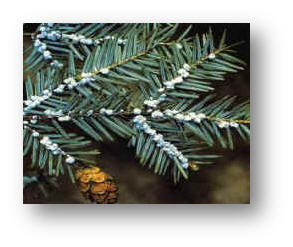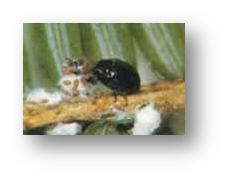Bombaci Tree Care, LLC
Independently Owned & Operated
Hemlock Sprays
The wooly adelgid was first noted in the United States in 1924
when it began inhabiting Hemlock trees found in the Pacific
Northwest. Since its discovery, this pest has been steadily
multiplying and continues to spread to the north, south, east, and
across the country. The USDA Forest Service estimates the adelgid is
spreading at a startling rate of about 15 miles per year. The wooly
adelgid can be carried by the wind, birds, deer, and even humans; it
was introduced to the state of Connecticut by Hurricane Gloria.
Since there is no natural predator for this insect, the two native
American species of Hemlock trees (the Eastern Hemlock and the
Carolina Hemlock) face a very real threat of extinction. The Eastern
Hemlock, native to Connecticut, has become the most endangered as it
is a favorite host for the wooly adelgid.
It is not
difficult to determine if a Hemlock tree is infested with the wooly
adelgid.
 The insect is named for its appearance as it spends a
majority of its life sheathed in a wooly, white egg sac that is
similar in size and shape to that of a Q-tip. These egg sacs can be
found near the base of almost every needle on a branch. Female
adelgids deposit anywhere from 50 to 300 eggs per egg sac during the
months of February through June; after this time they remain on the
host, over-wintering on the branches of the Hemlocks. The eggs then
start to hatch in April and they continue to hatch through June. Of
the newly hatched adeglids, some develop into wingless females that
remain on the Hemlock and produce yet another generation of pests.
Others find places to settle and begin to feed, and still more grow
wings and fly off to find a new Hemlock host. The adelgids that
remain lay a second batch of eggs that start to hatch in June and
continue the hatching process through mid-July. This second
generation will then remain dormant until October when it will begin
the cycle again during the winter months. A new generation then
hatches the next February and the cycle continues once again.
The insect is named for its appearance as it spends a
majority of its life sheathed in a wooly, white egg sac that is
similar in size and shape to that of a Q-tip. These egg sacs can be
found near the base of almost every needle on a branch. Female
adelgids deposit anywhere from 50 to 300 eggs per egg sac during the
months of February through June; after this time they remain on the
host, over-wintering on the branches of the Hemlocks. The eggs then
start to hatch in April and they continue to hatch through June. Of
the newly hatched adeglids, some develop into wingless females that
remain on the Hemlock and produce yet another generation of pests.
Others find places to settle and begin to feed, and still more grow
wings and fly off to find a new Hemlock host. The adelgids that
remain lay a second batch of eggs that start to hatch in June and
continue the hatching process through mid-July. This second
generation will then remain dormant until October when it will begin
the cycle again during the winter months. A new generation then
hatches the next February and the cycle continues once again.
The wooly adelgid feeds throughout all four seasons, with the
greatest amount of damage taking place during in the spring months.
These small, "aphid-like" insects are sap suckers that enjoy feeding
on the newer branches of the Hemlock. The adelgid feeds where the
needles attach to the branch, injecting saliva that is toxic into
the branch during the feeding process. The needles then turn from a
dark green to a grayish green, dry up, and drop off. The saliva that
is injected prevents the tree from being able to produce new needles
causing the whole limb of the tree to become adversely affected.
These limbs usually die within the first summer and the entire tree
typically succumbs to the pest within 1 to 4 years.
Hemlock deaths can be prevented and the wooly adelgid's spread can
be stopped. A certified arborist can keep this pest under control by
applying a treatment of specialized horticultural oil. This oil
saturates the undersides of the branches, killing the adelgid while
leaving the Hemlock completely unharmed. This is the only way to
keep this pest from spreading. Other types of pesticides do not stop
the lifecycle of the wooly adelgid.
For more information on our Hemlock sprays or to arrange for a free
estimate, please contact us
or use the free estimate request on this page.